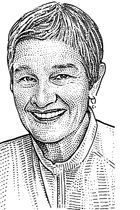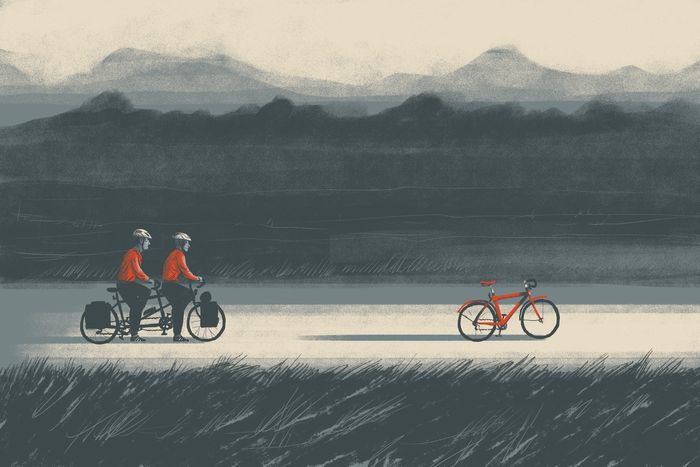Steve
We came 6 inches from death, maybe 4, just west of Leoti, Kan., in September on our tandem bicycle. Ever since, we’ve been asking: Should we each have a Plan B, a backup road map for retirement with the other suddenly gone?
 Our brush with mortality came on a sunny morning as a tailwind pushed us along a thinly trafficked road, a glorious cycling day in the prairie after 2,200 miles of glorious riding from Oregon. This was precisely the kind of adventure we looked forward to having years into retirement—on the road, together.
Our brush with mortality came on a sunny morning as a tailwind pushed us along a thinly trafficked road, a glorious cycling day in the prairie after 2,200 miles of glorious riding from Oregon. This was precisely the kind of adventure we looked forward to having years into retirement—on the road, together.
A distant semi appeared in our mirrors. The driver would surely shift left to pass, as thousands had done before on our bike tours. The truck grew bigger, staying its course. I steered onto the shoulder. It got bigger. We pedaled nearer the grass.
“Wham!” A metallic ripping sound rushed by us, and the bike shuddered violently.
Two seconds later, the truck was shrinking down the road as we coasted to a stop and looked back. Our left pannier bag and its squashed contents were splayed along the pavement. The driver had sideswiped us, tearing off the bag and rolling over it.
Bodies and bike were unscathed. Psyches were not. “Six inches. It came that close,” I said, holding my thumb and index finger apart. “Four,” replied Karen, pointing to her cracked handlebar mirror.
We began trembling with the realization that we could have died, then still more after Karen asked, “What if it had been just one of us?”
We had departed home two months earlier leaving behind a will and instructions to our sons about what to do if we died. We had no plan for if only one of us did. Now, after we bungied our smashed luggage onto the bike and got back on, we broached the Plan B question.
Even though a number of acquaintances about our age have recently lost a longtime partner—lost to heart attacks, freak falls, disease—it all felt hypothetical. The trucker turned the question painfully real.
There’s the easy stuff we can address now. We consulted our financial planner, who said our assets could sustain either of us alone and urged us to make sure all critical stuff was under joint control.
I should add Karen to my vintage-motorcycle titles and confirm we both have control over the phone plans and credit cards. I’ll compile a list of passwords. A mourning survivor shouldn’t need to deal with locked accounts or the DMV.
The harder part is existential. Is it advisable to even imagine scenarios now for retirement without Karen in the picture? To sketch out contingency plans to get a job, sell the house, travel alone, move near the kids or become a hermit?
One solo senior suggests we study how happily retired singles keep their lives enriched. “One thing married people need to know,” she says, “is that it’s possible to have a good life without a partner.”
A few hours after our truck terror, we arrived in Marienthal, Kan., and stood for a tearful minute of silence at the metal sculpture there alongside Kansas 96, a rider on a white bike memorializing cyclist John Egbers.
He died in 2018 at age 64 after a driver hit him nearby on the same cross-country bike route as ours, the TransAmerica, leaving behind his wife of 44 years and their plans for retirement together. His memorial’s inscription: “We are all diminished by one.”
We pedaled another 17 miles to Scott City, but our world had changed. We called it quits there, 220 miles from our goal.
We still wear the yellow wristbands with John’s name on them that the bakery at Marienthal gave us, reminders of how we must acknowledge that life may suddenly leave us without the one dearest to us.
Karen
Plan A is ingrained in me. I have my daily and weekly schedules, my near-future plans and scenarios for what retirees often call their go-go, slow-go and no-go years.
 They all include Steve.
They all include Steve.
Now, as our brush with death forces me to consider life without him, I can think about a Plan B for only about five minutes. It’s too painful.
Rather than making several contingency plans, I have cobbled together a generic, overall plan during those minutes of thought I force on myself—a plan I think Steve would also appreciate having. He is welcome to borrow and adapt.
The most important element in my Plan B: I must be part of a caring community, one that brings soup and fresh bread and a listening ear, one that can continue to provide the human connections I would need for months and years. I have that community now.
I would continue on for a year or so with few changes and get stabilized in my familiar home as I live into my new reality. Then I’d simplify, downsize and reduce responsibilities.
I would then move to a smaller place with fewer oversight concerns where I can be comfortable but also be away from for long periods. I know I can live healthily by myself. I’ve done it before, and I don’t mind the prospect at some point. I cherish quiet time, and I keep a structured schedule and build in time with others.
Where to live when I’m alone? That would be my main worry. In that year of living without changes, I’d figure it out. Own or rent? I’d get counsel from our financial planner.
Some time in this first year, I would bring together friends who were in my situation to share experiences. I did just this when I faced six months living alone, 13 years ago when Steve took our youngest son on a trip through East Africa to Istanbul, and I gained important advice.
But then my five minutes is up, and it’s hard to go on. Even just thinking about a Plan B feels as if I’m cheating on Steve. And I get this odd feeling that the thinking itself might make the need for the plan likely sometime sooner.
Perhaps we should be taking a less threatening, more collaborative approach that our pastor suggests. “What would you wish for me if I had to live without you?” she suggests we ask each other. “Where might you want me to live, who would you want me to be surrounded by, what support would you like me to have, how would you imagine me ‘investing in life’ after such a great loss?”
The stark reality of a Plan B also suggests something we can do now: Live our lives with a new compassion for those who are already without a late partner, drawing them in, including them in gatherings—gaining wisdom from them.
We asked John Egbers’s widow for her wisdom. We, like John, launched on the TransAmerica in our 44th year of marriage. He and she, like we, anticipated joint adventures afterward for years to come.
Susan Egbers, 69, says she planned to retire after her husband reached Virginia—he had joined the annual race on the route—so they could travel in a camper for a year and “see all the beautiful things in America.”
She faced “horrible loneliness” for three years after he died, she says, until she woke up one morning at the couple’s Minnesota home and decided to move to a Florida beachside condo.
“You really can’t prepare for it,” she says. She advises us instead to use our scare to learn to look past each other’s idiosyncrasies. “Don’t let the small stuff bug you,” she says. “Just enjoy each other.”






